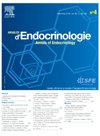Transcriptomic study of adrenal stress genes in rats exposed to 5G electromagnetic fields
IF 2.9
3区 医学
Q3 ENDOCRINOLOGY & METABOLISM
引用次数: 0
Abstract
Introduction
The biological effects of 5G electromagnetic fields on living organisms are poorly understood. Studies suggested that exposure to radio frequencies, and notably 2G fields (900 MHz), may alter the structure and function of the adrenal glands, impacting hormonal response to stress. The effect of 5G fields (3.5 GHz) on these mechanisms, however, is not known.
Objective
To assess the impact of exposure to 2G and 5G electromagnetic fields on the expression of genes involved in the adrenal stress response in rats at different developmental stages.
Material and methods
Male Wistar rats were divided into 2 age groups: juveniles (3 weeks) and young adults (8 weeks). They were exposed to 900 MHz (2G) and 3.5 GHz (5G) electromagnetic fields at an intensity of 1.5 V/m in 2 daily 1-hour sessions, for 2 weeks. Expression of adrenal stress genes (CH25H and StAR) and corticosteroidogenic enzymatic cofactors (CYP-11a1, CYP-21a1 and HSD-3b1) was assessed on RT-qPCR.
Results
No significant changes in transcriptomic expression were observed, whatever the developmental stage or exposure intensity. Grouping the animals by exposure condition revealed no significant effect of electromagnetic fields on the adrenal markers studied (Figure 1).
Discussion and conclusion
Contrary to some studies suggesting an effect of radio frequencies on adrenal function, in the present study 2-week exposure to 5G or 2G fields did not alter the expression of stress genes. It would be useful to explore longer exposure and higher intensity to assess possible long-term effects and reproduce real-life conditions of exposure to electromagnetic fields.
5G电磁场暴露大鼠肾上腺应激基因转录组学研究
5G电磁场对生物体的生物效应尚不清楚。研究表明,暴露于无线电频率,特别是2G场(900兆赫),可能会改变肾上腺的结构和功能,影响荷尔蒙对压力的反应。然而,5G场(3.5 GHz)对这些机制的影响尚不清楚。目的探讨2G和5G电磁场对不同发育阶段大鼠肾上腺应激反应相关基因表达的影响。材料与方法雄性Wistar大鼠分为幼鼠(3周龄)和青壮年(8周龄)2组。他们被暴露在900 MHz (2G)和3.5 GHz (5G)的电磁场中,强度为1.5 V/m,每天2次,每次1小时,持续2周。RT-qPCR检测肾上腺应激基因(CH25H和StAR)和促皮质类固醇酶辅因子(cypp -11a1、cypp -21a1和HSD-3b1)的表达。结果无论发育阶段或暴露强度如何,转录组表达均无明显变化。按暴露条件分组的动物显示,电磁场对所研究的肾上腺标志物没有显著影响(图1)。讨论和结论与一些研究表明射频对肾上腺功能有影响相反,在本研究中,暴露于5G或2G场2周并没有改变应激基因的表达。探索更长的暴露时间和更高的强度,以评估可能的长期影响,并重现暴露于电磁场的真实情况,将是有益的。
本文章由计算机程序翻译,如有差异,请以英文原文为准。
求助全文
约1分钟内获得全文
求助全文
来源期刊

Annales d'endocrinologie
医学-内分泌学与代谢
CiteScore
4.40
自引率
6.50%
发文量
311
审稿时长
50 days
期刊介绍:
The Annales d''Endocrinologie, mouthpiece of the French Society of Endocrinology (SFE), publishes reviews, articles and case reports coming from clinical, therapeutic and fundamental research in endocrinology and metabolic diseases. Every year, it carries a position paper by a work-group of French-language endocrinologists, on an endocrine pathology chosen by the Society''s Scientific Committee. The journal is also the organ of the Society''s annual Congress, publishing a summary of the symposia, presentations and posters. "Les Must de l''Endocrinologie" is a special booklet brought out for the Congress, with summary articles that are always very well received. And finally, we publish the high-level instructional courses delivered during the Henri-Pierre Klotz International Endocrinology Days. The Annales is a window on the world, keeping alert clinicians up to date on what is going on in diagnosis and treatment in all the areas of our specialty.
 求助内容:
求助内容: 应助结果提醒方式:
应助结果提醒方式:


